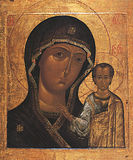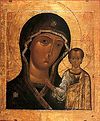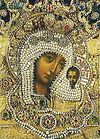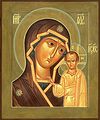

| Previous day | Next day |
| Old Style
October 22
|
Saturday |
New Style
November 4
|
| 22nd Week after Pentecost. Tone 4. | No fast.
|
![]() The Kazan Icon of the Most Holy Theotokos (commemorating the deliverance from the Poles in 1612).
The Kazan Icon of the Most Holy Theotokos (commemorating the deliverance from the Poles in 1612). ![]() Holy Equal-to-the-Apostles Abercius, bishop and wonderworker, of Hierapolis (167).
Holy Equal-to-the-Apostles Abercius, bishop and wonderworker, of Hierapolis (167). ![]() The Holy Seven Youths (“Seven Sleepers”) of Ephesus (see August 4) (250 and ca. 446).
The Holy Seven Youths (“Seven Sleepers”) of Ephesus (see August 4) (250 and ca. 446).
Hieromartyr Alexander, bishop, and Martyrs Heraclius, Anna, Elizabeth, Theodota, and Glyceria, at Adrianople (2nd-3rd c.). Sts. Theodore and Paul, abbots, of Rostov (1409).
New Hieromartyrs Seraphim (Samoilovich), archbishop of Uglich, Menas (Shelaev) and Herman (Polyansky), archimandrites, and Alexander Lebedev, Vladimir Sobolev, Basil Bogoyavlensky, and Alexander Andreyev, priests (1937). New Hieromartyr Gregory (Vorobiev), abbot, of Koprino (Yaroslavl) (1937).
Martyr Theodoret, at Antioch (362). Sts. Lot and Rufus, of Egypt (5th c.). St. George the New Confessor, of Drama (Greece) (1959).
Repose of Monk Joseph the Silent, of Kuban (1925), Metropolitan Nestor of Kamchatka and Petropavlovsk (1962), and Protopresbyter Michael Pomazansky (1988).
Articles
 St. Abercius the Bishop and Wonderworker of Hieropolis, Equal of the ApostlesSaint Abercius, Bishop and Wonderworker of Hieropolis lived in the second century in Phrygia. |
 7 Holy Youths “Seven Sleepers” of EphesusThe Seven Youths of Ephesus: Maximilian, Iamblicus, Martinian, John, Dionysius, Exacustodianus (Constantine) and Antoninus, lived in the third century. |








